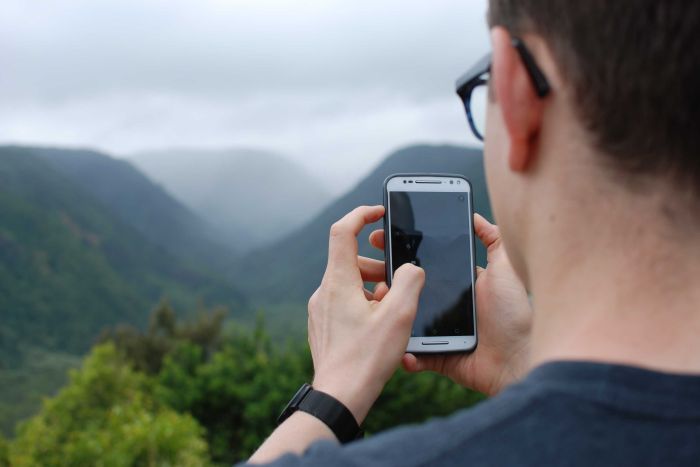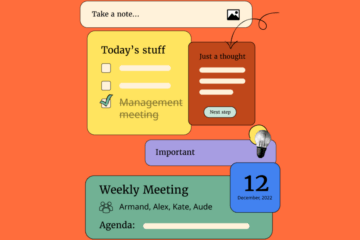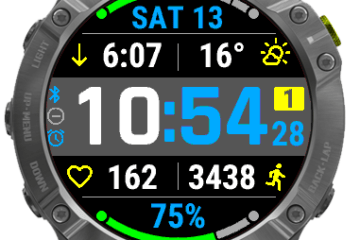
As mobile ownership continues to rise, the number of apps available grows — and many of those apps are geared at helping you find out more about the world around you, not the digital one at your fingertips.
Some will help you identify the plants on your street or trees in your neighbourhood, while others show you how you can spend less around your home by saving energy.
Others still let you contribute to global databases of scientific information as part of a burgeoning app-based citizen science movement.
Contents
- 1 Astronomy — SkySafari, Solar Monitor, Fireballs in the Sky
- 2 Weather — BOM, Pocket Weather Australia, Weatherzone, Weather Underground
- 3 Plants and animals — Field Guide to NSW Fauna, Questagame, iNaturalist
- 4 Energy — Solar Analytics, Zero Carbon, Carbon Footprint Calculator, Light Bulb Saver
- 5 Anatomy — The Human Body, Human Anatomy Atlas
Astronomy — SkySafari, Solar Monitor, Fireballs in the Sky
For avid stargazers or those just starting out there’s a range of apps to suit your experience and interests.
David Finlay is an astronomy photographer who uses mobile apps to chase and photograph natural events like eclipses and comets.
He said the app he used most when finding out what the sky would look like on any given night wasSkySafari.
SkySafari lets you simulate the night sky from any location at the planet, at any point in time — including right now, or in weeks or months to come.
“So I can go, ‘what’s visible tonight? Where are the planets going to be? Where are the stars and the galaxies going to be? And that app can show me that. It’s incredibly powerful,” Mr Finlay said.
In 2013, as an asteroid passed close by to Earth, he stood in the middle of a cow paddock at Jamberoo on the New South Wales south coast, and used the app to pinpoint where the asteroid would be.
“I could then focus my telescope on that part of the sky, and there I was, photographing this asteroid that was so close to the Earth you could see it moving in real-time through the telescope.”
 PHOTO: A 20-second exposure photograph of asteroid 2012 DA14, taken by David Finlay after tracking down the asteroid with an app (Supplied: David Finlay)
PHOTO: A 20-second exposure photograph of asteroid 2012 DA14, taken by David Finlay after tracking down the asteroid with an app (Supplied: David Finlay)To track the stunning and elusive Aurora Australis — southern lights — Mr Finlay uses Solar Monitor.
Solar Monitor tells you space weather conditions, like how fast and dense the solar wind is. It’ll also give you notifications if the Sun is particularly active, which is usually a good sign for aurora chasers.
Mr Finlay said he had seen Aurora Australis more than 30 times in the past 15 years from the Wollongong area, in part because of the help of the app — a rare feat, given the natural phenomenon usually is not visible further north than Tasmania.
And for those who want to contribute their bit to humankind’s wider scientific knowledge, Fireballs in the Skywill let you do just that.
The app, produced by Curtin University, gets people to record their observations and GPS location if they observe a meteorite fall.
The idea is that if enough people make an observation, scientists can use the data to triangulate the location of the meteorite fall. Such falls are often difficult to locate because they’re rare, and because Australia’s low population density means observations are limited.
Though Mr Finlay is excited about the possibilities apps open up when it comes to exploring the sky, he warns you should put down the phone when the action’s happening.
“Once you use these apps to connect to the outer world, make sure you enjoy the experience,” he said.
“Make sure you spend the time with your eyes up looking at the sky rather than down at your feet.”
Weather — BOM, Pocket Weather Australia, Weatherzone, Weather Underground
If you’re craving more information about the weather than the morning minute on radio or TV gives you, apps could be the answer.
James Goldie, from the Climate Change Research Centre at the University of New South Wales, is enthusiastic about the various apps available in the area.
The thing Mr Goldie stresses is that your app of choice should use data from the Bureau of Meteorology, because it means professional meteorologists have gone over the forecast and you know it’s coming from a trusted source.
One option is the BOM’s own newly released weather app.
“The nice things about the BOM weather app are that it’s free, it’s really simple to use, I wouldn’t hesitate to recommend it to someone who doesn’t use smartphones very much because it’s nice and clear,” Mr Goldie said.
The app lets you look up local weather, see rainfall over a geographical region in the past hour, and access forecasts for the day and week ahead.
Mr Goldie said while the BOM app is a good option for those who want to get a quick idea of the weather on the run, there are options that provide more in-depth information.
He recommends Pocket Weather Australia, which has the added option of notifying you when unusual weather events are happening — things like severe weather warnings and storms.
And for weatherphiles, the Weatherzone apps lets you dig deep into the data.
“You can look at things like historical weather statistics. If you have a subscription you can look at their lightning tracker, which is all very cool,” Mr Goldie said.
For those who want to try something a little different, Weather Underground is attempting to make your weather ‘hyperlocal’. It doesn’t just want to tell you what conditions are like in your city — it wants you to know when it’s going to rain in your neighbourhood or street.
But Mr Goldie said while the idea sounds exciting in theory, the app may not be fully accurate as it sources some data from amateur weather stations.
“It’s a good idea, but I’m not sure how much I’d want to rely on an amateur weather station, because they’re pretty easy to set up poorly,” he said.
Plants and animals — Field Guide to NSW Fauna, Questagame, iNaturalist
With vast swathes of digital information before us, it can be easy to forget about the natural world. But there are ways to bring the two together.
Paul Flemons, the manager of digital collections and citizen science at the Australian Museum, suggests a number of apps for those interested in getting to know more about the world around them.
Chief among those apps are the free field guides on Australia’s fauna. Published by various museums around the country, including the Australian Museum, there’s an app for each state. Together, they include information on more than 2,100 animals, including distribution maps, images, and species descriptions.
Mr Flemons said these apps are good for general use, and have a large amount of information within them.
Questagame is another app he recommends for those wanting to gamify their nature spotting. The app lets you take photographs of animals or plants and submit them, where experts identify the flora or fauna in the photograph and award points based on its rarity.
 PHOTO: Some plant and animal apps are geared towards children (Annie Spratt: public domain)
PHOTO: Some plant and animal apps are geared towards children (Annie Spratt: public domain)iNaturalist is a similar app, and both Questagame and iNaturalist allow you to contribute information to global biodiversity databases. Mr Flemons said doing so is useful for scientists the world over.
“They’re becoming more useful in a scientific sense, because apps are being built that allow people to submit information, images and sightings which contribute to the overall scientific knowledge for biodiversity, not just in Australia, but around the world,” he said.
“The mobile technology and the rising number of apps is what’s starting to engage people in citizen science. It was fairly niche until the mobile apps became available. It’s really taken citizen science to another level.”
Energy — Solar Analytics, Zero Carbon, Carbon Footprint Calculator, Light Bulb Saver
John McKibbin is a research principal at the University of Technology’s Institute for Sustainable Futures. He said there are a number of apps that can help people reduce their energy bill and carbon footprint.
Solar Analytics, available for solar panels, monitors the output of a solar system once a monitor is installed, and alerts homeowners if their solar panel has a fault or isn’t working properly.
“They can also give you rich insights on when you’re generating electricity, how much you’re expected to generate,” Mr McKibbin said.
Mr McKibbin, who has founded a start-up in the energy app space, said people can also save energy through home automation systems like Google Home, the Amazon Echo, and Apple’s HomeKit, which allow you to control lights, heating, and appliances in your home and set schedules to ensure energy isn’t wasted.
While the tools he mentions are powerful, they rely on external inputs to provide the information needed for the apps to run. But there are plenty of other apps available that use your smartphone alone.
Carbon footprint calculators, like Zero Carbon on iOS or Carbon Footprint Calculator on Android, let you plug in how much you spend on electricity and water, and how long your appliances are on, to calculate your carbon footprint and provide tips on how you can reduce it.
And there’s a number of apps produced by Energy Rating, the joint initiative of Australia’s state and federal governments, as well as the New Zealand Government.
Energy Rating’s Light Bulb Saver lets you know which light bulbs will save you money. Its Energy Rating app helps you calculate how much you’ll spend keeping an appliance running over time, and how different appliances compare.
Anatomy — The Human Body, Human Anatomy Atlas
There’s a vast natural world out there, but an equally fascinating and diverse one exists inside each and every one of us. Apps mean thousands of years of anatomical study can fit in the palm of your hand.
Marcus Robinson is curator of Sydney University’s J.T Wilson Museum of Human Anatomy, and has been exploring the different anatomy apps out there. He said one of the most impressive features some apps have on offer is the 3D fly-through.
“The skeleton, you can go through holes in the bones or into the ribcage and look from any perspective that you choose, and it’s all very intuitive,” he said.

“You can look back, down, out, up, any orientation you choose, you can go through it in virtual space. That’s very advantageous for learning anatomy, it being such a 3D thing.”
Most of the apps in the anatomy space are encyclopaedic, giving an overview of the bones, muscles, organs and other parts that make up the human body. They vary from the simple and straightforward The Human Body, for iOS, which is geared at children, to the detailed Human Anatomy Atlas.
Mr Robinson said anatomy apps could change the way the subject is taught to students.
“Students once upon a time would have textbooks, bulky things to carry around with them. Having apps, you can have lots of different media you can use to add to your course notes and written notes.”
[Source:-News ABC]




